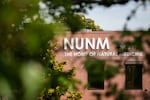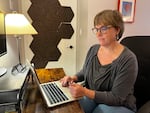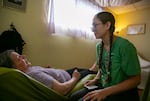
A sign for National University of Natural Medicine, the oldest accredited university of naturopathic medicine in North America, on the university's campus near downtown Portland, Ore., Aug. 19, 2024.
Anna Lueck / OPB
Editor’s note: This story is the second in a two-part series about the challenges Portland alternative medicine graduates are facing in paying off their debts. The first of the series was published Thursday.
By most measures, Juniper Martin has a successful career. She runs a busy primary care practice in Portland where she sees up to three dozen patients a week. Her average yearly take-home pay is between $60,000 and $70,000 a year.
The work is fulfilling. But Martin said financially it has not paid off.
“I have meaningful work and not a lot of people can say that. I’m lucky for that,” said Martin. “But at the end of the day, I have a ball-and-chain that I can’t ignore.”
Martin graduated from the National University of Natural Medicine in 2007 with a naturopathic medicine degree, taking out around $200,000 in student loans for the five-year program. Because of compounding interest, her loans have ballooned into almost $400,000.
Martin said NUNM administrators constantly reassured her that she was getting trained as a medical doctor and that her degree would put her at the forefront of medicine. The Oregon Board of Naturopathic Medicine defines naturopathic physicians as primary care doctors with specialized training in natural medicine.
However, there’s a big difference between the training and finances involved in becoming a conventional doctor and the path to becoming a naturopathic physician. Medical doctors — MDs — take years longer to get their degrees, take out less in student loans on average, and then earn significantly more after graduation.
“They are selling us on something, and they do not say, ‘Hey, you’re going to graduate and make $50,000,’” said Martin. “There is a responsibility there.”

Juniper Martin is a naturopathic doctor who operates a primary care practice in Portland, Ore. She graduated from the National University of Natural Medicine in 2007 with about $200,000 in student loan debt.
Tiffany Camhi / OPB
Leaders at Oregon’s alternative medicine colleges insist they shared relevant information with students so they could make their own decisions.
Melanie Henriksen, NUNM’s president and CEO, said her school didn’t mislead students.
“We absolutely feel the weight of employment challenges felt by our graduates,” said Henriksen in an emailed statement. “We are very transparent about this fact with our entering students and prepare them as best we can while they are in school to be successful after they graduate.”
Martin is part of a group of hundreds of graduates from NUNM and the Oregon College of Oriental Medicine who are seeking recourse from their schools. The former students say both institutions left out critical information about the realities of the alternative medicine workforce: minimal jobs, low pay and the likelihood they work for themselves.
Of the more than 57,000 jobs currently listed on the Oregon Employment Department’s website, only nine are for naturopaths and five are for acupuncturists. Nearly half of those jobs are non-permanent, contract positions.
At the same time, the recent graduates say they’ve been left with hundreds of thousands of dollars in student loan debt they can’t pay off.
Now the graduates are planning to apply for help through a federal loan forgiveness program called Borrower Defense to Repayment. But getting their loans discharged through that process will be no easy task: they’ll have to prove to the U.S. Department of Education that the schools misled them.
A protection for student loan borrowers
Borrower Defense to Repayment is rooted in civil rights legislation. The loan forgiveness program was first codified in the early ‘90s, as an amendment to the Higher Education Act of 1965, which aimed to make college more accessible and affordable by authorizing federal student aid programs. Borrower defense differs from the recent controversial attempts at blanket student loan forgiveness from the Biden Administration, because its primary function is to protect students from fraudulent institutions.
“What borrower defense does is essentially provide an escape valve for students who have been victimized by predatory schools,” said Kyle Southern, an associate vice president at the Institute for College Access and Success, a nonprofit group that advocates for affordability, accountability and equity in higher education.
Students who believe their schools misled them may be eligible to get the entirety of their loans discharged. But graduates seeking this type of loan forgiveness have a high bar to prove their case. Successful borrower defense claims must provide testimony describing how and when a school misrepresented itself and how that misrepresentation has negatively impacted the graduate’s life. Simply saying a degree program wasn’t worth the money won’t cut it.
Complicating this type of claim further are different sets of rules the U.S. Department of Education must follow when reviewing applications. A claim from a person who took out federal student loans 10 years ago will follow different rules than an application from someone who borrowed loans five years ago.
Southern said graduates from OCOM and NUNM do have a compelling case. But he said any new applications for borrower defense could take years for the Education Department to adjudicate. The federal program has a backlog of more than 700,000 applications.
“They’re going to be coming in the back of the line behind a long backlog,” said Southern. “They could be waiting for years to get this relief.”
And Southern said because of the sheer volume of unresolved claims and continued upheaval of the program, it’s impossible to know how successful these claims are.
OCOM’s president and CEO Phil Lundberg said the school has received a handful of borrower defense applications from the Education Department.
“I can say with a pretty high degree of confidence that there was no ongoing effort to deceive people or that we tried to increase program involvement inappropriately,” said Lundberg. “We didn’t do that.”
Henriksen said similarly, that NUNM has not deceived students.
There are other avenues former students can pursue for debt relief, but they offer their own shortcomings and tradeoffs.
A remedy for alternative medicine education
Haley Merritt, a 2013 OCOM graduate, took out $156,000 in student loans for her education. She changed the direction of her personal and professional life to deal with the debt.
Unlike the vast majority of acupuncturists who work as self-employed contractors, Merritt has been able to find steady work at a clinic for the past 11 years, Working Class Acupuncture in Portland.

Kathleen Preuss, left, chats with acupuncturist Haley Merritt before receiving treatment at Working Class Acupuncture's Hillsdale location, southwest Portland, Ore., Aug. 19, 2024. Working Class Acupuncture is a nonprofit community acupuncture clinic that seeks to make acupuncture more financially accessible.
Anna Lueck / OPB
Starting salaries at Working Class Acupuncture, or WCA, fall between the $34,000 to $40,000 range, below some living wage estimates for the metro area. The sliding-scale clinic became a nonprofit a year after Merritt began working there. That meant employees were eligible to apply for the federal government’s Public Service Loan Forgiveness program. This program discharges the remainder of a borrower’s loan obligation after 120 payments, or 10 years of monthly payments.
Merritt was notified that her federal student loan balance, which had grown to $220,000 with interest, would be forgiven in July. But getting out from under that debt has carried its own cost.
“I’ve really just modeled the last 11 years of my life around getting student loan forgiveness,” said Merritt. “I’ve been thinking about nothing else, doing nothing that would ever compromise that and putting everything else on the back burner.”
Merritt said she sacrificed life milestones, like buying a house or having another child in order to get her loans discharged.
She questions whether alternative medicine schools have students’ best interest in mind at all. Merritt said schools like OCOM and NUNM need to balance the costs of running an institution with the cost of the degrees.
“Overall, the education system is broken,” said Merritt. “It’s become a business instead of actually supplying people with an education they can take and then create a life with.”
The clinic where Merritt works has helped spearhead a training program that avoids some of the common pitfalls of expensive alternative medicine colleges, but it has its own limitations.
Limited options for less expensive degrees
POCA Tech is a joint project from WCA and the nonprofit People’s Organization of Community Acupuncture.
The accredited school, which is housed within WCA, offers a slimmed-down curriculum that prepares students to practice acupuncture. The school has a heavy emphasis on small business ownership and the realities of being an entrepreneur.
POCA Tech’s tuition and fees are a fraction of the cost of its main local competitors, NUNM and OCOM. The three-year program is estimated to cost approximately $25,000, roughly a quarter of what it costs to complete a degree at NUNM or OCOM.
But there are tradeoffs.
POCA Tech is by-design not eligible to award federal student loans. Founders of the school said they did not want students to graduate with loan balances. But that also means people who cannot pay out-of-pocket may be left out.
And POCA Tech students do not graduate with a master’s or doctorate level degree. Instead they receive a master’s level certificate, which means they can get licensed in Washington and Oregon but not in California.

Acupuncturist Haley Merritt drapes a blanket over patient Claris Mathew at Working Class Acupuncture's Hillsdale location.
Anna Lueck / OPB
Bex Groebner, an NUNM graduate and former faculty member at OCOM and NUNM, has another idea.
“Go through a public institution, Go through Portland State University,” said Groebner, who noted PSU offers a master’s degree in public health. “Just put an acupuncture program in there.”
Groebner said many public universities already offer Asian studies, anatomy and biology courses. She believes integrating an alternative medicine program into a larger school would significantly cut costs for students. Larger, public universities generally cost less than private schools, have economies of scale that reduce administrative overhead costs, and may be in a better position to offer grants and scholarships to reduce tuition costs for students.
But even if the education was made cheaper, practitioners entering alternative medicine are still set up to be paid poorly.
Groebner and other natural medicine professionals OPB spoke to said the health insurance landscape in the U.S. does not widely accept alternative medicine practices. One of the key revenue sources in health care — private insurance — often shortchanges alternative medicine, by paying low insurance reimbursement rates across the board.
OCOM’s website has highlighted that 67% of its graduates reported working in clinics that accepted insurance. But a study published in the Journal of the American Medical Association, or JAMA, in 2022 found inconsistent or partial reimbursement for acupuncture among most insurers, forcing patients to largely pay out-of-pocket for the treatment.
“It’s just discrimination against the medicine and insurance codes don’t get paid,” said Groebner. “And then the schools don’t go to bat for us.”
Who’s held accountable?
Under the Biden administration, the federal Education Department has sought to strengthen accountability measures to protect students from predatory colleges and universities.
It introduced new borrower defense rules in 2022 that would make it easier for students to pursue debt relief. New regulations that aim to provide more transparency around the value of degree programs at colleges went into effect on July 1.
Under these stronger, consumer-protection based rules, the Education Department could strip away federal financial aid funding from schools in violation. But depending on which administration takes shape after this year’s presidential election, some of these new measures could be reversed or not take effect at all.
“All those efforts are either subject to or currently under legislative attack or judicial attack,” said Southern with the Institute for College Access and Success. “There’s just been tremendous pushback from institutional higher ed forces.”
Southern said states play a role in protecting students, too. But he said states are often more focused on monitoring larger, public universities, making it easier for niche, private institutions like OCOM and NUNM to fly under the radar.
Oregon’s Higher Education Coordinating Commission has oversight with some private institutions, including OCOM. The school was authorized under the commission’s Office of Degree Authorization. OCOM was required to work with the higher ed commission on its closure plan and processes for non-graduating students who sought a tuition refund. A spokesperson said the commission does not have the explicit authority to consider student debt load when authorizing schools. NUNM is not under the commission’s purview.
In addition to state and federal guidelines, higher education institutions and programs are subject to monitoring by accrediting agencies. These agencies grant accreditation, signaling that colleges and universities have met baseline education standards, which allows them to participate in federally funded financial aid programs. But consumer protection advocates say there are many gaps when it comes to accreditation.
“It’s essentially a system of peer review, where representatives from other institutions in your field come in to do an evaluation every few years,” said Southern.
The Accreditation Commission for Acupuncture and Herbal Medicine, or ACAHM, evaluates programs at NUNM and OCOM. The agency requires institutions to track job placement and earnings of its graduates, but this data is not a key part of the program performance thresholds ACAHM uses to approve programs.

A sign for Oregon College of Oriental Medicine, a private school offering graduate degrees in acupuncture and traditional Chinese medicine, Old Town Portland, Aug. 19, 2024. Trustees voted to close the school on May 15, 2024, citing financial issues and low enrollment.
Anna Lueck / OPB
The problem of how to balance the sustainability of alternative medicine schools with successful student outcomes still remains to be solved.
And while the graduates of OCOM and NUNM that OPB spoke to believe they received a well-rounded education, they thought the costs of the programs were exorbitant.
“I don’t believe there’s true malintent by the schools. What they provide has been useful and important,” said Martin, who graduated from NUNM in 2007. “But there is a real disconnect between what translates to the real world and there should be some responsibility for that.”
Martin and other graduates believe the schools should have been better advocates for its graduates by doing more to demonstrate the effectiveness of alternative medicine, working to fix declining insurance reimbursements and creating stronger partnerships with hospitals and clinics to help place graduates directly into jobs.
Martin applied for borrower defense in 2023. It could take up to three years for the Education Department to make a judgment on her case. If her loans do get discharged, Martin said it would feel like she’s in control of her life again.
“I could have some retirement saved. I could be present for my kids. I could be healthier,” said Martin. “At this point I’m gonna work until I die and I don’t love that.”
